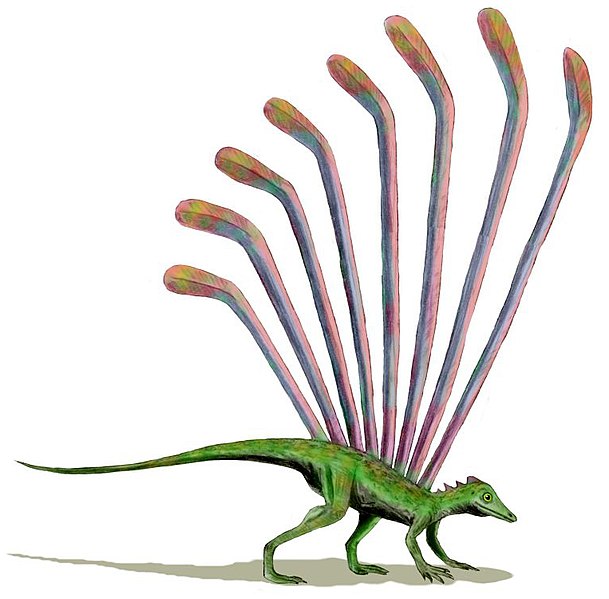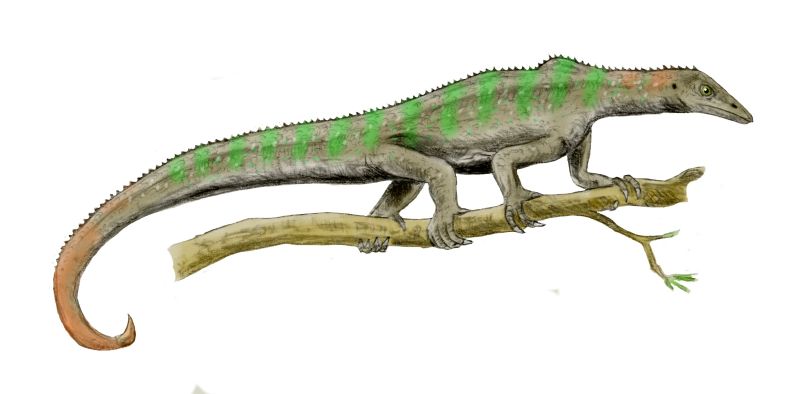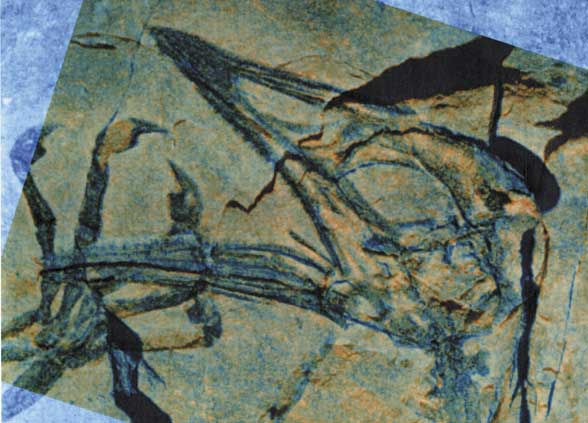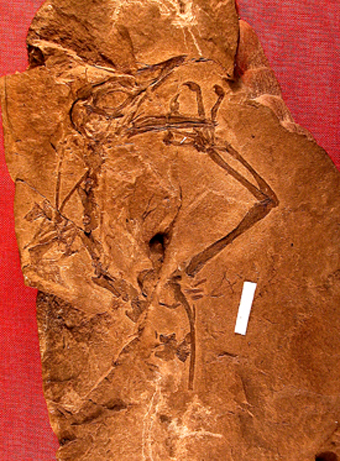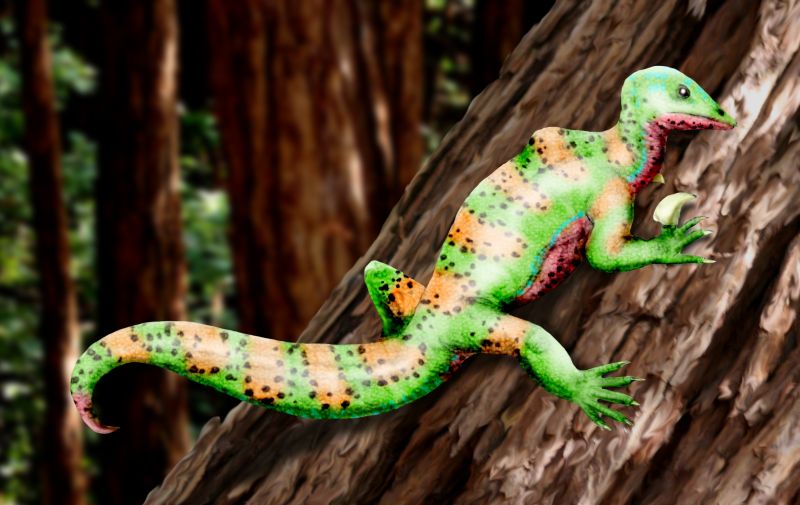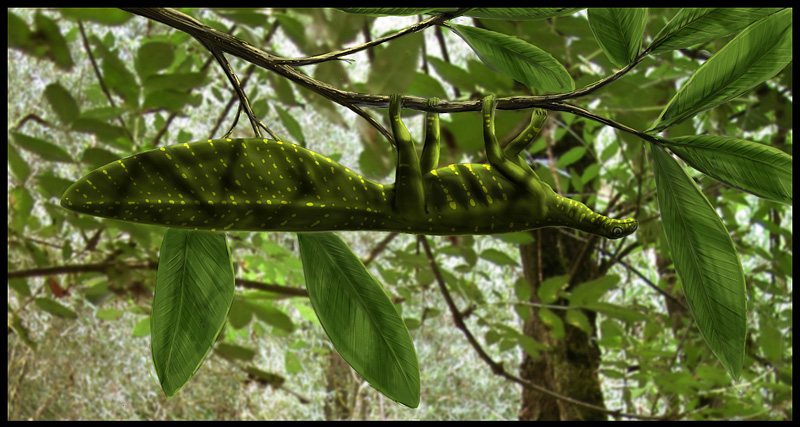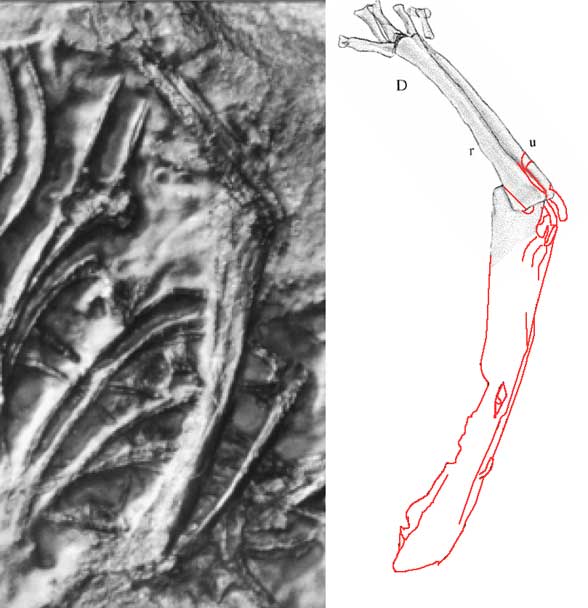[Recent Entries][Archive][Friends][User Info]
February 5th, 2012
| February 5th, 2012 | |
|---|---|
| 12:30 pm [industrialterro] [Link] |
Longisquama Лонгисквама или длинночешуйник (Longisquama insignis) — ископаемая ранняя рептилия с длинными спинными чешуеподобными придатками, обитавшая в позднем триасе на территории Средней Азии. Известна по неполной окаменелости, найденной на территории урочища Мадыген Ферганской долины (Киргизстан). Ископаемые останки представляют собой переднюю часть скелета с черепом с отчетливыми отпечатками удлинённых и накладывающихся друг на друга чешуек в горловой области и по заднему краю передней конечности. Сейчас окаменелость находится в коллекции Палеонтологического института РАН в Москве. Систематическое положение до конца не выяснено. В разных источниках рассматривается авторами как лепидозавр, пролацертилия, или как архозавроморф входящий в состав группы Avicephala наряду с Coelurosauravidae, Drepanosauridae, Protoavis. Некоторые авторы рассматривают лонгискваму даже как мелкого динозавра. Сам палеонтолог А. Г. Шаров относил лонгискваму к ветви архозавров, родственно связанных с птицами. К такому выводу он пришел после изучения особенностей строения ископаемых останков — наличия у лонгисквамы предорбитального отверстия, ключиц, подобного птичьему киля, и строения спинных придатков. Спинные придатки длинные, длиной 10—12 см, расширенные на конце, с опахалом и полым осевым стержнем, базальная часть которого сужена и закруглена. Расположение и предназначение длинных чешуйчатых спинных придатков остается спорным. На реконструкциях чешуи обычно располагаются на спине. Однако не известно в каком положении — в горизонтальном или вертикальном, в один или два ряда они располагались у животного. Неизвестно также были ли они подвижными. Наиболее распространенная теория, впервые высказанная первооткрывателем Шаровым, гласит, что спинные придатки формировали своеобразный «парашют», обеспечивающий планирующий полет. Также считается, что чешуи могли использоваться для регуляции теплообмена или в социальном поведении этих животных. Особо скептические исследователи склонны считать, что найденные отпечатки являются вовсе не чешуями, а фрагментами растений. Лонгисквама вероятно обитала на деревьях, питаясь насекомыми. The question of what kind of reptile Longisquama is, and what exactly the 'long scales' are, relates to a wider debate about the origin of birds, and whether or not they are descended from dinosaurs. A consensus of paleontologists is persuaded by the hypothesis that birds evolved from advanced theropod dinosaurs. The scenario for this hypothesis is that early theropod dinosaurs were endothermic, and evolved simple filamentous feathers for insulation. These feathers later increased in size and complexity and then adapted to aerodynamic uses. Scientists in this camp usually regard Longisquama as a curious diapsid with specialized scales, ambiguous skeletal features, and no real significance to bird evolution. However, a few scientists prefer the hypothesis that birds evolved from small, arboreal archosaurs like Longisquama. They see these as ectothermic animals that adapted to gliding by developing elongated scales and then pennaceous feathers. The high energy demands of gliding drove the animals to become endothermic and the feathers were then coopted to double as insulation. The basic debate is over thirty years old but both sides draw evidence from recent findings of apparently feathered dinosaurs. For decades Martin asserted that the anatomical similarities between dromaeosaurid dinosaurs and birds were more convergences, and not credible evidence of a close relationship. The discovery of the dromaeosaurid Microraptor, a small dinosaur with simple filamentous feathers as well as the long flight feathers characteristic of birds, had major ramifications for the debate about what sort of animal might be the most probable ancestor of birds. Researchers like Padian (1985) had hypothesized a running, terrestrial dinosaur developing feathers and the ability to flap, and Martin and Feduccia were particularly critical of that idea. But Microraptor was interpreted by Xu et al. (2003) as a small, arboreal, gliding dinosaur, thus going beyond the former terrestrial dinosaur/arboreal archosaur opposition. However, in 2004, in response to Microraptor, Martin proposed that Microraptor is a close relative of birds after all but that it, along with all maniraptoran dinosaurs, were not dinosaurs at all. He proposed what he called a compromise hypothesis that all maniraptorans are instead flightless birds, in a scenario where birds evolved from a Longisquama-like basal archosaur first. Martin credits this hypothesis to Gregory S. Paul, but Paul is a strong advocate of the relationship of dinosaurs and birds, and believes that maniraptorans are dinosaurs.
Репродукции (1, 2, 3, 4, 5, 6, 7, 8, 9, 10, 11):
( Далее )
Tags: Вымершие рептилии, Триас, авицефалы, диапсиды |
| Time | Event |
| 01:09 pm [industrialterro] [Link] |
Megalancosaurus Megalancosaurus is a genus of extinct reptile from the Late Triassic period of Northern Italy, and one of the best known drepanosaurids. The type species is M. preonensis; a translation of the animal's scientific name would be "long armed reptile from the Preone Valley". Megalancosaurus was fairly small, its adult length was only about 25 centimeters (10 inches). It was built like a chameleon and probably lived a similar arboreal lifestyle. Even its feet were chameleon like, with two toes being opposed to the remaining three. The tail is long, prehensile, and bears a strange claw like organ made of fused vertebrae at its end. Its shoulders formed a withers that would have served as an attachment site for especially strong muscles. Some specimens have an opposable digit on the feet. Because not all members of the species appear to bear this digit, it has been speculated that it is an instance of sexual dimorphism, only being possessed by whatever gender needed a stronger grip on the branch during copulation.
Tags: Вымершие рептилии, Триас, авицефалы, диапсиды, дрепанозавроморфы |
| Time | Event |
| 01:32 pm [industrialterro] [Link] |
Drepanosaurus Drepanosaurus is a genus of arboreal (tree-dwelling) reptile that lived during the Triassic Period. Only one specimen of Drepanosaurus has thus far been found. Sadly this specimen was incomplete and lacked a head and neck. Drepanosaurus was probably an insectivore, and lived in a coastal environment in what is now modern Italy. A full sized adult Drepanosaurus had a length of about half a meter. Its name means "scythe lizard", which is thought to refer either to the enlarged claw on its forelimb, or the claw-like structure at the tip of its prehensile tail. The structure at the end of the tail is made of fused vertebrae. The forelimb of Drepanosaurus is highly modified compared to other vertebrates and very robust. Its ulna was altered from being a forearm bone into an odd crescent shaped site for muscle attachment. The role played by the ulna in most tetrapods is replaced by an elongated carpal bone. Additional musculature would be attached to the high withers that characterized Drepanosaurus and its close relatives. A clue to the purpose of these large muscles can be found on its hand. The animal's "index finger" bore a large claw reminiscent of those born by dinosaurs such as Noasaurus and Baryonyx. However it is more likely that Drepanosaurus used its claw like the modern pygmy anteater, tearing through bark and insect nests to find invertebrate prey. Some researchers have forwarded the more far-fetched proposal that the claw was used to excavate burrows, but this is unlikely.
Tags: Вымершие рептилии, Триас, авицефалы, диапсиды, дрепанозавроморфы |
| Time | Event |
| 01:46 pm [industrialterro] [Link] |
Hypuronector Hypuronector is a genus of extinct reptile from the Triassic Period that lived in what is now New Jersey. The etymology of the name translates as "deep-tailed swimmer from the lake." A member of the Simiosauria, Hypuronector is related to the arboreal Megalancosaurus. It was a small animal, estimated to be only 12 cm long in life. So far dozens of specimens of Hypuronector are known, but despite this, scientists have not found any complete skeletons. This makes attempts to reconstruct Hypuronector's body or life-style highly speculative and controversial. Despite their evolutionary relationship, it has been suggested by some scientists that Hypuronector may have had a different ecological niche than other Simiosaurs. It has long been accepted that Megalancosaurus was an arboreal chameleon-like animal. However, Hypuronector has been suggested to be aquatic due to its deep, paddle-like tail and the fact that its remains were found in an ancient lake bottom. The only current remains of Hypuronector are too scanty to reach a certain conclusion about the lifestyle practiced by members of the genus. The discovery of the animal's hands and feet might demonstrate adaptations present in its relatives for an arboreal lifestyle, which would help settle the debate. Unfortunately, paleontologists have no remains from Hypuronector's head, neck, feet or hands and thus must await future discoveries.
Tags: Вымершие рептилии, Триас, авицефалы, диапсиды, дрепанозавроморфы |
| Time | Event |
| 02:03 pm [industrialterro] [Link] |
Vallesaurus Vallesaurus is an extinct genus of Late Triassic elyurosaur drepanosauromorph. First found in Northern Italy in 1975, it is one of the most primitive drepanosaurs. V. cenenis is the type species, named in 2006. A second species, V. zorzinensis, was named in 2010. Vallesaurus is a small drepanosaurid about 15 centimetres (5.9 in) long. It is pentadactyl, with the 4th digit being longest and equal in length to the humerus. Its tarsus has a centrale, or an ankle bone which articulates with the tibia. In addition, Vallesaurus also has modified distal tarsals and metatarsals, and a clawless hallux. Vallesaurus differs in some characteristics from another drepanosaur, Megalancosaurus. Vallesaurus has a proportionally shorter and higher snout, a thicker and larger maxilla and set of maxillary teeth, and a shorter cervical vertebra. It also lacks the fusion between the neural spines of the second and third dorsal vertebrae. Vallesaurus differs from Drepanosaurus, another drepanosaur, in that it lacks the enormous claw found on the second digit of the manus. It can be distinguished from Drepanosaurus, Megalancosaurus and possibly Dolabrosaurus in the lack of a terminal spine at the end of the tail. In addition, Vallesaurus also differs from Hypuronector, a related drepanosaur, in having anteroposteriorly extended neural spines of the anterior dorsal vertebrae and forelimbs much shorter than the hindlimbs. Vallesaurus shares with all other known drepanosaurids a body structure that indicates a specialized adaptation toward climbing, especially on narrow supports such as the twigs of trees. The manus of Vallesaurus has no opposable fingers; however, the shape and length of the fingers suggest good climbing abilities. Vallesaurus as well as other drepanosaurids possess a fussed-like structure in the anterior dorsal region and highly modified cervical vertebrae with adaptations that limited lateral mobility. Both structures indicate the presence of powerful muscles and ligaments for the extension of the neck. This possibly suggests a projectile feeding adaptation. The head was suddenly launched forward to catch prey and the limited lateral mobility prevented undesired jerks of the neck which could have dislocated the cervical vertebrae during the quick extension. In smaller drepanosaurids like Megalancosaurus and Vallesaurus, such adaptations may be related to an insectivorous diet. The teeth of Vallesaurus seem well suited to cut or crush the tough exoskeleton of insects and other arthropods.
Tags: Вымершие рептилии, Триас, авицефалы, диапсиды, дрепанозавроморфы |
| Time | Event |
| 02:18 pm [industrialterro] [Link] |
Endennasaurus Endennasaurus is an extinct genus of thalattosaurian from the Upper Triassic of Italy. Endennasaurs is represented by two specimens, the holotype (5170, Bergamo Museum of Natural Sciences), exposed from the ventral side and lacking the left posterior limb and almost the entire tail, and a second specimen (paratype MBSN 27 in the same collection) exposed from the dorsal side and consisting of few dorsal vertebrae and ribs, part of the pelvic girdle, the right femur and the complete tail. The skull is narrow and elongate, the premaxillae are long, forming anteriorly a pointed rostrum and posteriorly a well developed process; both upper and lower jaw and palatine bones are toothless; frontals are long and narrow, forming most the upper margin of the orbits; occiput lying anteriorly to the quadrate suspension; the upper temporal fenestra is slit like or closed as in thalattosaurs. The neck is rather elongate with vertebrae amphicoelous; there are 12 cervical, 16 dorsal, 2 sacral and up to 67 caudal vertebrae. The trunk is stout and heavy with pachyostotic ribs and massive gastralia. The tail is very long and laterally compressed. The humerus is stout, with expanded and flattened distal head. The femur is slender and about twenty per cent longer than the humerus. There are sligthly reduced ossification in the carpus and in the tarsus. The carpus is represented by the ulnare, intermedium and centrale (the radiale was retained as cartilage) along with the first four distal carpals. Fifth distal tarsal is lost; fifth metatarsal is weakly hooked; phalangeal formula of the pes is primitive: 2,3,4,5,4.As suggested by the general structure of the skeleton Enndennasaurus shows a high degree of adaptation toward aquatic life expressed mainly by the stout distally enlarged humerus, the massive gastralia and the long, laterally compressed tail. Endennasaurus could have moved on land better than the other Thalattosaurs and this reptile probably lived near the coast preying on small organisms. Its long pointed "beak" does not seem an adaptation to catch fishes or to prey on hard shelled molluscs. Endennasaurus preys had to be small animals that did not have a strong shell or exoskelton like some crustaceans and small vertebrates.
Tags: Вымершие рептилии, Триас, диапсиды, талаттозавры |
| Previous Day | 2012/02/05 [Archive] |
Next Day |
